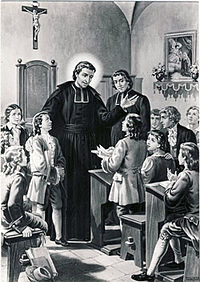
APRIL 28 is the traditional memorial of ST. LOUIS MARY DE MONTFORT (1716).
Louis Marie Grignion was born in Montfort, Brittany, France on January 31, 1673. He was the son of Jean Baptiste Grignion, a Crown lawyer of the town and the Parliament and a treasurer of the factory of St. Jean. He was an honored official and of little means. Louis-Marie was one of the eleven children of eighteen who survived childhood. The father had a bad temper, which Louis-Marie seems to have inherited, yet worked all his life to control.
The child demonstrated great docility and qualities of virtue. By age 4, he could console his mother by words that are unavailable to a toddler. It was as if God had put the words into his mouth. Little Louis learned quickly and taught other children the catechism.
At age 12, Louis entered St. Thomas’s, a Jesuit college. He learned care of the poor and sick and self-mortification, and he realized his vocation there. To Louis, the priesthood meant total servitude and self-sacrifice to God. Once he decided this, he vowed to never have personal possessions. He even decided to give up his surname and went by “De Montfort” after this.
When he went to his assigned seminary, St. Surplice in Paris, he chose to walk the 250 miles. He gave away the money given to him and gave away his new clothes in exchange for pauper’s rags. Louis had to beg for food. Once at the seminary, Louis succeeded well in courses, visited the chapel between classes, self-mortified, stopped and spoke to every statue of the Blessed Virgin and organized an association of “Slaves of Jesus in Mary”. The school administrators tried to break him down to no avail.
Louis was ordained in 1700 and entered the world of spiritual ignorance. Jansenism, a heresy, taught that almost all human frailties caused a separation from hope and chance of forgiveness. It encouraged the withdrawal from Communion as an act of humility. Believers called devotion to the Merciful Heart of Jesus as a sin of presumption and devotion to the Immaculate Heart of Mary as a sin of idolatry. This spread to bishops and priests, too.
Waiting almost a year to be allowed to preach, Louis took to the streets of towns, like Poitiers, where he addressed the poor and ill, especially. The populace were so enthralled that they begged the bishop to give him a position. He was assigned a very badly run hospital that catered to the poor. Louis reorganized the hospital, and worked side by side with the workers, caring and preaching simultaneously.He was condemned for it. Complaints mounted until the bishop forbade him to say Mass. Louis quit.
For several years, this pattern was followed. His reputation proceeded him. He preached Faith and the Rosary, the poor listened and he got into trouble with the bishops. He left.
In 1706, Louis walked to Rome to visit the Pope. After explaining his position, Louis was granted the status of “missionary apostolate”. He had the blessings of the Pope to go wherever and preach. For the next ten years, he preached compelling tracts and wrote. He converted many, having great success in the Vendee, the area where the French revolutionaries met with the greatest resistance 70 years later.
He became a virtual working machine, writing a number of books on Mary, composing 20,000 simple hymns for the villages he went to, and organizing two religious orders, Sisters of Divine Wisdom, who cared for the poor, and Missionaries of the Company of Mary, who also went out to preach. There were two attempts on his life, a poisoning and a beating, but he survived both. He begged and walked to sustain himself.
Worn out, Louis Marie de Montfort, died, holding a cross on one arm and a statue of the Blessed Virgin in the other. He was only 43.
Pope Pius XII canonized him in 1947.
If you say the Rosary faithfully until death, I do assure you that, in spite of the gravity of your sins you shall receive a never fading crown of glory.
St. Louis de Montfort

Recent Comments